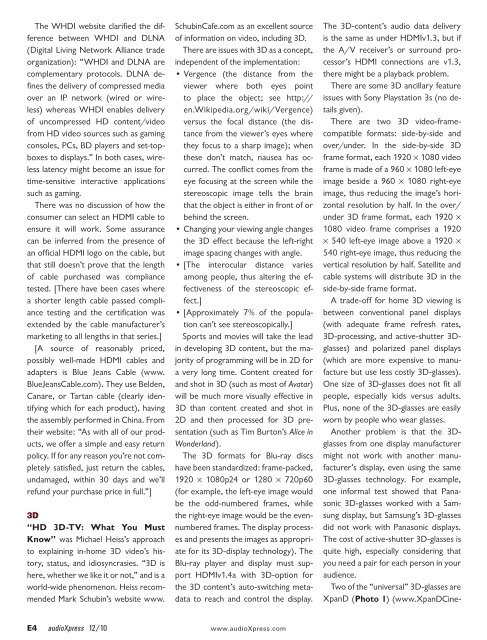A TUNE-UP FOR THE DUAL TURNTABLE - ThaiHDbox
A TUNE-UP FOR THE DUAL TURNTABLE - ThaiHDbox
A TUNE-UP FOR THE DUAL TURNTABLE - ThaiHDbox
You also want an ePaper? Increase the reach of your titles
YUMPU automatically turns print PDFs into web optimized ePapers that Google loves.
The WHDI website clarified the difference<br />
between WHDI and DLNA<br />
(Digital Living Network Alliance trade<br />
organization): “WHDI and DLNA are<br />
complementary protocols. DLNA defines<br />
the delivery of compressed media<br />
over an IP network (wired or wireless)<br />
whereas WHDI enables delivery<br />
of uncompressed HD content/video<br />
from HD video sources such as gaming<br />
consoles, PCs, BD players and set-topboxes<br />
to displays.” In both cases, wireless<br />
latency might become an issue for<br />
time-sensitive interactive applications<br />
such as gaming.<br />
There was no discussion of how the<br />
consumer can select an HDMI cable to<br />
ensure it will work. Some assurance<br />
can be inferred from the presence of<br />
an official HDMI logo on the cable, but<br />
that still doesn’t prove that the length<br />
of cable purchased was compliance<br />
tested. [There have been cases where<br />
a shorter length cable passed compliance<br />
testing and the certification was<br />
extended by the cable manufacturer’s<br />
marketing to all lengths in that series.]<br />
[A source of reasonably priced,<br />
possibly well-made HDMI cables and<br />
adapters is Blue Jeans Cable (www.<br />
BlueJeansCable.com). They use Belden,<br />
Canare, or Tartan cable (clearly identifying<br />
which for each product), having<br />
the assembly performed in China. From<br />
their website: “As with all of our products,<br />
we offer a simple and easy return<br />
policy. If for any reason you’re not completely<br />
satisfied, just return the cables,<br />
undamaged, within 30 days and we’ll<br />
refund your purchase price in full.”]<br />
3D<br />
“HD 3D-TV: What You Must<br />
Know” was Michael Heiss’s approach<br />
to explaining in-home 3D video’s history,<br />
status, and idiosyncrasies. “3D is<br />
here, whether we like it or not,” and is a<br />
world-wide phenomenon. Heiss recommended<br />
Mark Schubin’s website www.<br />
SchubinCafe.com as an excellent source<br />
of information on video, including 3D.<br />
There are issues with 3D as a concept,<br />
independent of the implementation:<br />
• Vergence (the distance from the<br />
viewer where both eyes point<br />
to place the object; see http://<br />
en.Wikipedia.org/wiki/Vergence)<br />
versus the focal distance (the distance<br />
from the viewer’s eyes where<br />
they focus to a sharp image); when<br />
these don’t match, nausea has occurred.<br />
The conflict comes from the<br />
eye focusing at the screen while the<br />
stereoscopic image tells the brain<br />
that the object is either in front of or<br />
behind the screen.<br />
• Changing your viewing angle changes<br />
the 3D effect because the left-right<br />
image spacing changes with angle.<br />
• [The interocular distance varies<br />
among people, thus altering the effectiveness<br />
of the stereoscopic effect.]<br />
• [Approximately 7% of the population<br />
can’t see stereoscopically.]<br />
Sports and movies will take the lead<br />
in developing 3D content, but the majority<br />
of programming will be in 2D for<br />
a very long time. Content created for<br />
and shot in 3D (such as most of Avatar)<br />
will be much more visually effective in<br />
3D than content created and shot in<br />
2D and then processed for 3D presentation<br />
(such as Tim Burton’s Alice in<br />
Wonderland).<br />
The 3D formats for Blu-ray discs<br />
have been standardized: frame-packed,<br />
1920 � 1080p24 or 1280 � 720p60<br />
(for example, the left-eye image would<br />
be the odd-numbered frames, while<br />
the right-eye image would be the evennumbered<br />
frames. The display processes<br />
and presents the images as appropriate<br />
for its 3D-display technology). The<br />
Blu-ray player and display must support<br />
HDMIv1.4a with 3D-option for<br />
the 3D content’s auto-switching metadata<br />
to reach and control the display.<br />
E4 audioXpress 12/10 www.audioXpress.com<br />
The 3D-content’s audio data delivery<br />
is the same as under HDMIv1.3, but if<br />
the A/V receiver’s or surround processor’s<br />
HDMI connections are v1.3,<br />
there might be a playback problem.<br />
There are some 3D ancillary feature<br />
issues with Sony Playstation 3s (no details<br />
given).<br />
There are two 3D video-framecompatible<br />
formats: side-by-side and<br />
over/under. In the side-by-side 3D<br />
frame format, each 1920 � 1080 video<br />
frame is made of a 960 � 1080 left-eye<br />
image beside a 960 � 1080 right-eye<br />
image, thus reducing the image’s horizontal<br />
resolution by half. In the over/<br />
under 3D frame format, each 1920 �<br />
1080 video frame comprises a 1920<br />
� 540 left-eye image above a 1920 �<br />
540 right-eye image, thus reducing the<br />
vertical resolution by half. Satellite and<br />
cable systems will distribute 3D in the<br />
side-by-side frame format.<br />
A trade-off for home 3D viewing is<br />
between conventional panel displays<br />
(with adequate frame refresh rates,<br />
3D-processing, and active-shutter 3Dglasses)<br />
and polarized panel displays<br />
(which are more expensive to manufacture<br />
but use less costly 3D-glasses).<br />
One size of 3D-glasses does not fit all<br />
people, especially kids versus adults.<br />
Plus, none of the 3D-glasses are easily<br />
worn by people who wear glasses.<br />
Another problem is that the 3Dglasses<br />
from one display manufacturer<br />
might not work with another manufacturer’s<br />
display, even using the same<br />
3D-glasses technology. For example,<br />
one informal test showed that Panasonic<br />
3D-glasses worked with a Samsung<br />
display, but Samsung’s 3D-glasses<br />
did not work with Panasonic displays.<br />
The cost of active-shutter 3D-glasses is<br />
quite high, especially considering that<br />
you need a pair for each person in your<br />
audience.<br />
Two of the “universal” 3D-glasses are<br />
XpanD (Photo 1) (www.XpanDCine-



